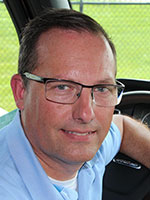Senior Reporter
NACFE to Monitor Downtime in Run on Less — Electric

[Stay on top of transportation news: Get TTNews in your inbox.]
As the North American Council for Freight Efficiency prepares for its Run on Less — Electric event, a real-world demonstration slated for September of zero-emission goods movement, it expects vehicle downtime likely to be a factor and something to chart.
At the same time, NACFE believes this showcase will underscore the need to think of an electric vehicle’s range on a charge in the same way as miles per gallon in an internal combustion engine.
RELATED: Fleets selected for Run on Less — Electric event
“We recognize downtime could be an issue. These trucks are nascent in their maturity,” NACFE Executive Director Mike Roeth said. “We expect, possibly, some problems. Even as simple as not plugging in the truck overnight and there not being a charge the next day.”

Roeth
NACFE has been discussing this with the fleets and truck builders involved in the showcase, Roeth said, and if there is a downtime event that is significant, the group will share why it happened what the parties did about it.
Downtime was not apparent in NACFE’s two earlier showcases. The first, Run on Less 2017, focused on longhaul routes and the seven drivers averaged 10.1 mpg. During the second event, Run on Less Regional, 10 drivers averaged 8.3 mpg hauling in a wide variety of regional-haul applications.
In those showcases, the trucks were just up and running and had no downtime issues such as involving tires or aftertreatment systems, Roeth said.
Meanwhile, NACFE already is watching how some of the electric trucks headed to the showcase are performing, and learning a lot about the first drivers, too.
“We’ve witnessed in a few trucks drivers who are not letting the battery get below 50%,” Roeth said. “So possibly if they are making a couple of trips to the port, maybe they are only going once with the electric truck. Maybe that driver takes a diesel truck for the other run into port.”

Reich
Rob Reich, NACFE board chair and chief administrative officer at Schneider, said drivers go through a different learning curve with an electric truck compared with a diesel they had been driving.
That curve can last a month or two, he said.
“I think there is a level of caution initially. No one wants to be the test driver who runs out of battery power before they get back home,” Reich said.
But what Schneider also has seen is once that comfort level with the truck is there, drivers are doing a nice job of maximizing the range and learning regenerative braking and all the things that come with the truck, he said.
How ready are #ElectricTrucks to deliver #ZeroEmissions freight? We are exploring this question in a real-world, real-freight electric truck demonstration. See which trucking fleets will help @RunonLess: https://t.co/vtXSXyLB5N pic.twitter.com/I78fD6xEfx — North American Council for Freight Efficiency (@NACFE_Freight) March 31, 2021
“They love the drive; we’ve had very positive feedback on simply the experience of driving the truck,” Reich said.
Schneider ranks No. 5 on the Transport Topics Top 100 list of the largest for-hire carriers in North America.
The carrier is testing a Freightliner eCascadia, a Class 8 tractor, through 2021 to address potential challenges to widespread use of commercial battery-electric vehicles.
Meanwhile, Roeth said what’s interesting is conceptually the amount of range in an electric truck is exactly the same as mpg.
“So the fact these drivers and fleets are being careful as they operate an electric truck with respect to how much regenerative braking are they using, how fast are they driving, how much stopping and starting in traffic are they doing — the more they are trying to benefit and get longer range. That’s what NACFE has been trying to get people to do with respect to fuel economy on gasoline trucks and diesel trucks forever,” Roeth said.
Only 14.3% of the truck driver population is made up of African Americans, followed by 13% Hispanic, and 7% Asian. In this episode, host Michael Freeze wonders what industry leaders are doing to increase those percentages. We talk to two trucking industry experts who have implemented their own practices that are contributing to a more diverse work community. Hear a snippet, above, and get the full program by going to RoadSigns.TTNews.com.
Run on Less – Electric will involve 13 private and public fleets and a mix of vehicles — including yard tractors — from 13 OEMs.
The three-week event will start Sept. 3 at ACT Expo in Long Beach, Calif., and feature metrics and daily real-world stories on the Run on Less website. The demonstration’s finale will take place at the North American Commercial Vehicle show in Atlanta on Sept. 28-30, according to NACFE.
A boot camp will be held for those interested in learning more about electric trucks. Registration is available online.
The first session is scheduled for April 20, followed by new training every other Tuesday through Aug. 24.
Want more news? Listen to today's daily briefing below or go here for more info:





